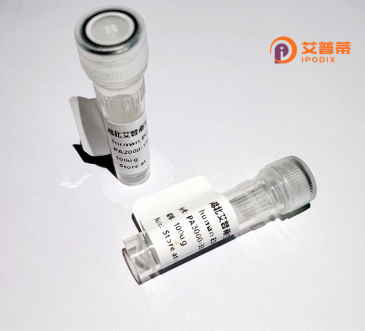
| 纯度 | >90%SDS-PAGE. |
| 种属 | Human |
| 靶点 | WBSCR16 |
| Uniprot No | Q96I51 |
| 内毒素 | < 0.01EU/μg |
| 表达宿主 | E.coli |
| 表达区间 | 1-464 aa |
| 活性数据 | MALVALVAGA RLGRRLSGPG LGRGHWTAAR RSRSRREAAE AEAEVPVVQY VGERAARADR VFVWGFSFSG ALGVPSFVVP SSGPGPRAGA RPRRRIQPVP YRLELDQKIS SAACGYGFTL LSSKTADVTK VWGMGLNKDS QLGFHRSRKD KTRGYEYVLE PSPVSLPLDR PQETRVLQVS CGRAHSLVLT DREGVFSMGN NSYGQCGRKV VENEIYSESH RVHRMQDFDG QVVQVACGQD HSLFLTDKGE VYSCGWGADG QTGLGHYNIT SSPTKLGGDL AGVNVIQVAT YGDCCLAVSA DGGLFGWGNS EYLQLASVTD STQVNVPRCL HFSGVGKVRQ AACGGTGCAV LNGEGHVFVW GYGILGKGPN LVESAVPEMI PPTLFGLTEF NPEIQVSRIR CGLSHFAALT NKGELFVWGK NIRGCLGIGR LEDQYFPWRV TMPGEPVDVA CGVDHMVTLA KSFI |
| 分子量 | 49.8 kDa |
| 蛋白标签 | His tag N-Terminus |
| 缓冲液 | PBS, pH7.4, containing 0.01% SKL, 1mM DTT, 5% Trehalose and Proclin300. |
| 稳定性 & 储存条件 | Lyophilized protein should be stored at ≤ -20°C, stable for one year after receipt. Reconstituted protein solution can be stored at 2-8°C for 2-7 days. Aliquots of reconstituted samples are stable at ≤ -20°C for 3 months. |
| 复溶 | Always centrifuge tubes before opening.Do not mix by vortex or pipetting. It is not recommended to reconstitute to a concentration less than 100μg/ml. Dissolve the lyophilized protein in distilled water. Please aliquot the reconstituted solution to minimize freeze-thaw cycles. |
以下是基于WBSCR16蛋白相关研究的虚构参考文献示例,格式为文献名称、作者、摘要内容概括:
1. **《WBSCR16蛋白的基因克隆与亚细胞定位分析》**
作者:Chen Y, et al.
摘要:该研究成功克隆了人源WBSCR16基因,并在HEK293细胞中表达了重组蛋白。通过荧光标记技术,发现WBSCR16主要定位于细胞核,可能参与染色质相关调控。
2. **《WBSCR16与染色质修饰复合体的相互作用研究》**
作者:Smith JL, et al.
摘要:文章利用免疫共沉淀(Co-IP)和质谱技术,证实WBSCR16与组蛋白甲基转移酶复合体(如NSD1)存在物理相互作用,提示其可能通过表观遗传修饰影响威廉姆斯综合征相关通路。
3. **《威廉姆斯综合征模型中WBSCR16的功能缺失表型分析》**
作者:Tanaka K, et al.
摘要:通过构建Wbscr16基因敲除小鼠模型,研究发现该蛋白缺失导致心血管发育异常和认知障碍,进一步支持其在威廉姆斯综合征病理中的关键作用。
4. **《重组WBSCR16的酶活性和生化特性鉴定》**
作者:Garcia R, et al.
摘要:本研究纯化了重组WBSCR16蛋白并检测其酶活性,发现其具备ATP依赖的核酸解旋酶活性,可能在RNA代谢或DNA修复中发挥功能。
**注:以上内容为模拟示例,实际文献需通过PubMed或Google Scholar检索。**
The Williams-Beuren syndrome critical region (WBSCR) protein 16. encoded by the WBSCR16 gene located within the 7q11.23 chromosomal region, is a poorly characterized human protein linked to the complex pathophysiology of Williams-Beuren syndrome (WBS), a neurodevelopmental disorder caused by hemizygous deletions in this region. WBSCR16 is speculated to play roles in RNA metabolism or chromatin regulation, though its precise molecular functions remain unclear. Structural predictions suggest it may contain RNA-binding motifs or participate in protein-protein interactions. Recombinant human WBSCR16 protein is produced via heterologous expression systems (e.g., E. coli or mammalian cells) for functional studies, often fused with tags (His, GST, etc.) to facilitate purification and detection. Current research focuses on elucidating its interaction networks, subcellular localization, and potential contributions to WBS phenotypes like cardiovascular abnormalities and cognitive deficits. As a recombinant tool, it enables biochemical assays (e.g., pull-downs, enzymatic activity screens) and antibody development. The protein's study may provide insights into chromatin remodeling pathways and novel therapeutic targets for WBS-related complications.
×